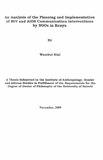An Analysis of the Planning and Implementation of HIVand AIDS Communication Interventions by NGOs in Kenya
Abstract
This study investigated whether organisations involved in HIVand AIDS
education have integrated effective communication planning and
implementation processes in their interventions. The study's overall
objective was to analyse the planning and implementation of the
communication interventions within non-governmental organisations
dealing with HIV,and AIDS.
Specifically, the study set out to: examine the extent to which
organisations involved in HIV and AIDS education programmes have
integrated an effective communication process at the decision-making
level; analyse the planning of the communication process of these
organisations with a view to assessing their conformity with acceptable
communication principles; and to identify the strengths, gaps and
constraints in the existing planning of the communication process of the
said organisations.
The study was conducted in Nairobi and Kisumu, where the
headquarters of the sampled organisations are. An inventory of six
hundred and forty-five organisations registered by the Kenya NGOAIDS
Consortium (KANCO)was used for multi-stage sampling. Two hundred
and sixty organisations were found to have educational and
communication interventions and these were isolated for study. These
isolated organisations were divided into three categories of international
and regional organisations, national organisations and local
organisations. These categories were then used to randomly select sixty
organisations which had information, education, and communication
(IEC)or communication as a major programme or project.
xi
Both primary and secondary sources of data were used. Primary data
were collected using a semi-structured questionnaire, and key informant
interviews. Data from the semi-structured interviews were analysed
using the Statistical Package for Social Sciences (SPSS), while data from
the key informant interviews were analysed along thematic areas and
used to support the information derived from the semi-structured
interviews. The findings are presented using triangulation, as well as visual
graphics, such as bar charts and pie charts.
The first major finding is that there were attempts to integrate an
effective communication process in the planning, design and decisionmaking
level. However, complete operationalisation or integration was
lacking as only 6% of the organisations had a person with training in
communication, in charge of communication interventions. Secondly,
there were components of behaviour change communication, combined
with awareness-raising for about 50% of the organisations. Finally, in
terms of strengths, the findings indicate that participation was well
integrated in most of the organisations' interventions.
The study therefore concludes that, first, the majority of organisations
have not fully integrated communication in a sustainable manner at the
decision-making level, in spite of their recognition that communication
should be integral to decision-making and planning. Second, about a half
of the organisations had embraced effective communication principles in
the implementation of their interventions. Finally, contrary to one of the
assumptions made in this study, participation was a key component for
about three-quarters of the organisations.
On the basis of these conclusions, the study recommends to the National
Aids Control Council (NACC) , that there is need for mapping of
organisations working on HIV and AIDS interventions, particularly with
regard to their communication efforts. The study also recommends
further research into the following areas: analysis of the contribution of
communication to lower prevalence rates in Kenya; the focus on HIVand
AIDS messaging; in-depth research on culture, sexuality and sexual
behaviour as this relates to communication; evaluation of HIVand AIDS
communication interventions in Kenya; audience studies on HIV and
AIDScommunication in Kenya; and the mass media and HIVand AIDS.
Citation
Kiai, W(2009). An Analysis of the Planning and Implementation of HIV and AIDS Communication Interventions by NGOs in KenyaSponsorhip
University of NairobiPublisher
Institute of Anthropology, Gender and African Studies
Description
Phd- Thesis

